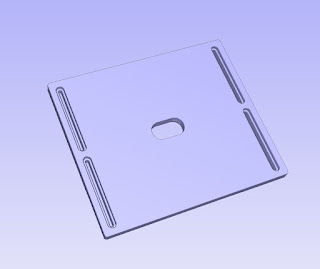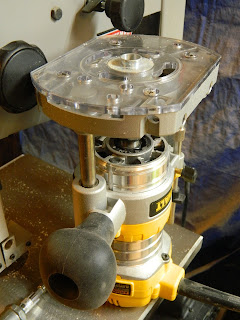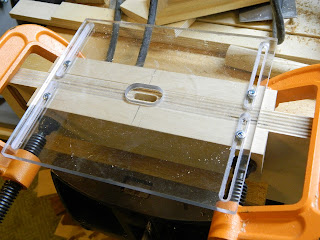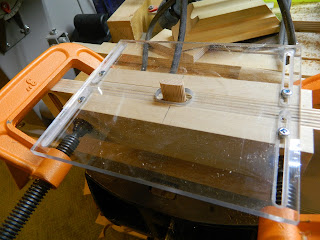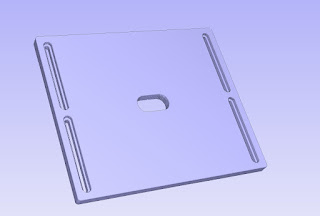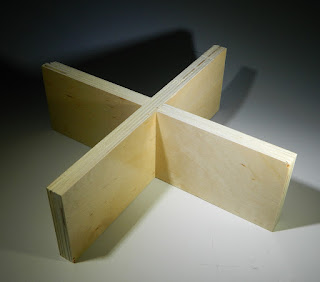In furniture or product design often what you hope will be a good design ends up with obvious room for improvement. This is why initial builds are considered to be prototypes. It takes seeing and testing the first prototype to realize where flaws exist or where there is room for improvement in aesthetics or strength or performance or functionality or simplicity of build.
Shown here is a sequence of Balans style chairs I designed and made. Inspired initially by the original rocking Balans chair my pursuit was to find a design that was simple to build, adjustable, and stable. In my PhDesk article photos you can see most of an earlier 3 caster perch version done as a class project by my students. The design was static with no adjustability or flexibility. Link: PhDesk Article
 |
| Imbuia Wood Collapsible |
My Imbuia and leather prototype above improves on that earlier student design with knee pads that could rotate to meet your shins at a whatever was the most comfortable angle. Initially the frame post beneath the seat was intended to be moved to different positions along the lower rails. This prototype revealed that changing the angle of the seat would also tilt the caster stems off vertical and reduce the ease of rolling the chair around. The frame could collapse by lifting the center post off the pin it rests on. Collapsed it would fit in a smaller box for shipping or storage. |
| 3 wheels Adjustable Height |
 |
| Highest Perch Position |
The 3 wheeled version above could be adjusted in height/angle. This design isolates the caster base from the adjustability of the seat and knee rest. An aluminum push button releases the aluminum post when pushed in and locks the post position when released. Knee pads pivot to meet shins at the most comfortable angle. |
| 4 Wheels Adjustable |
 |
| In use. |
While there is an economic benefit to using 3 casters rather that four, a 3 point footprint comes with a flaw discovered in use. They could tip and roll out from under the occupant when leaning to the back right or left. This four wheeled version eliminated the tipping flaw of all the 3 wheeled versions. This version stretched the frame back so the back caster beam was behind foot clearance. It had the same push button height adjustment and pivoting knee rest as the 3 wheeled version above. The sharp bend in the center frame of the 3 and 4 caster versions above required making them from 80 very thin veneer layers of wood. This later version used far fewer and thicker wood layers by changing the center frame to a smooth arc from under the seat down to the rear caster beam. Below a few photos of the arced frame. It has a seat that can be slid forward or back and locked in position with a cam lever. The arc made room under the frame for occupant heels to meet or cross. This final version was gifted to the International Woodworking Fair management office in Fall 1988.
 |
| Hinge Point |
 |
| Push Button Height Adjustment |
 |
| Cam Release Seat Adjustment |
The version above was the simplest build, the safest to sit on, and had adjustable height, seat position adjustment, and pivoting knee rests. It was a design that only came about after making and using the previous designs. They were all built in a university fab lab and benefited from being tried out by several students and other professors. Feedback gained from each version led to advancements in later versions. This sequence shows iterative progression in action. This iterative research help me gain promotion from Assistant Professor to Associate Professor at Kansas State University. An even later iteration I designed is my rocking Balans. You can read about it HERE.
Iteration during the sketching stage of an idea always leads my to something nicer, more unique than what I started with. Yet still, after building a piece, there might be slight imperfect aspect that deserve more iteration to improve. That was the case with my TV tray table design you can find here: An-improved-tv-tray-table-design
Nagging imperfections/details only found resolution with 3 following iterations:
1. Variations-of-tv-tray-table, Oak
2. Refinement-in-detail, Cherry
3. Tv-tray-table, Maple, 4th variation.
While my first Maple version worked fine, details in the shape of the outer legs, tension cables, and pivot bolts all found improvement in the following iterations. Details no sketch would have revealed as needing improvement.
Comments and questions are encouraged!
4D


